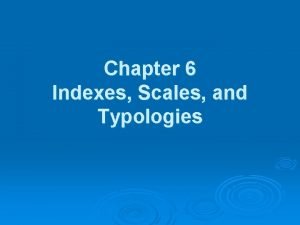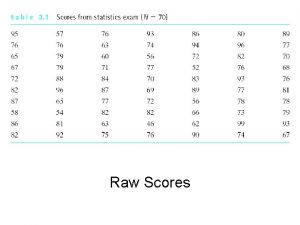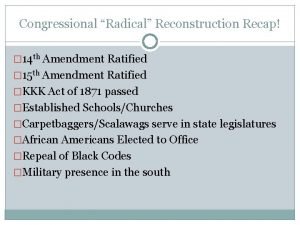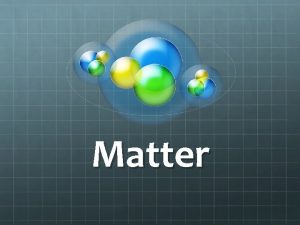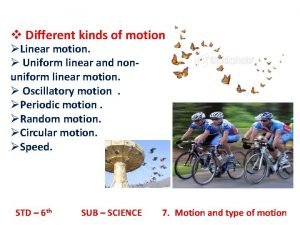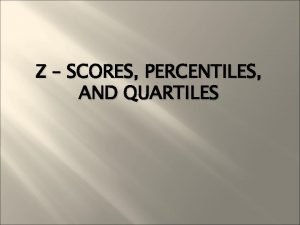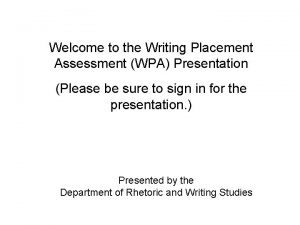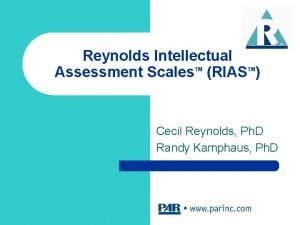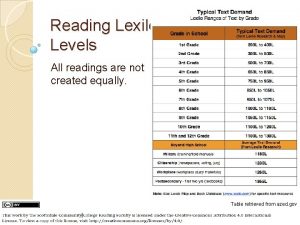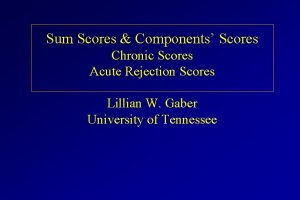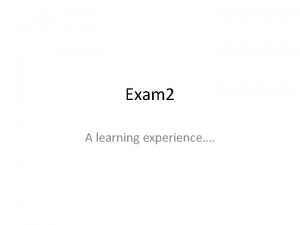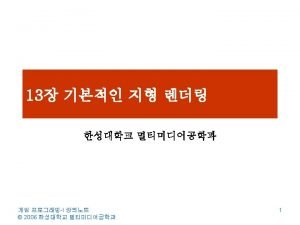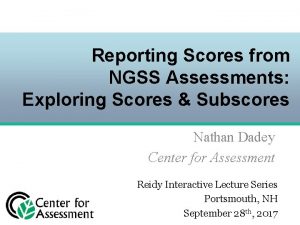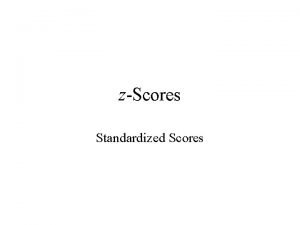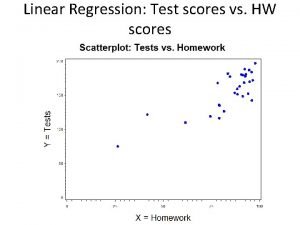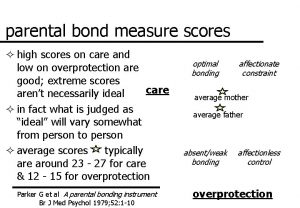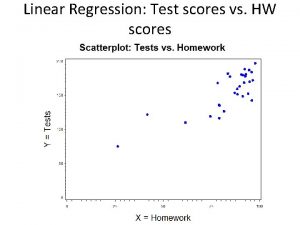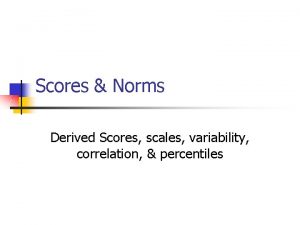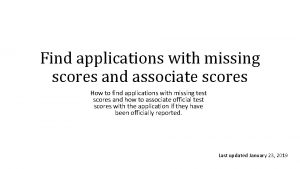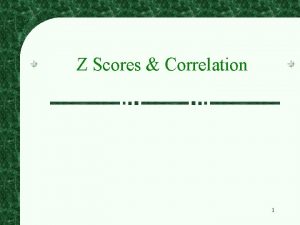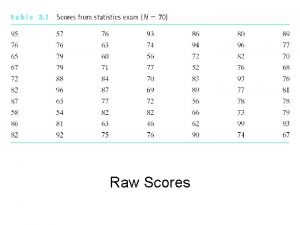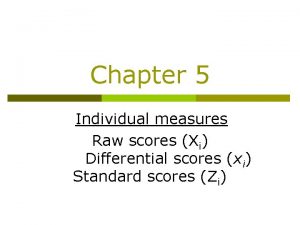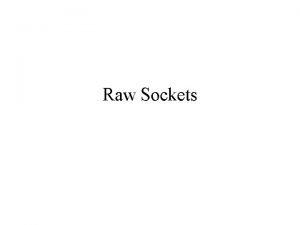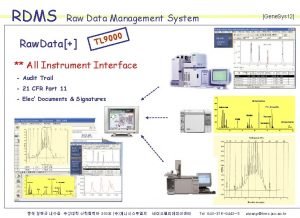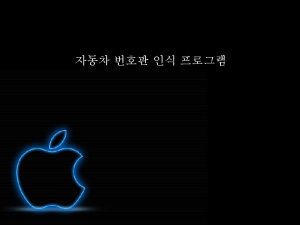Impact of Using Raw Versus Uniform T Scores

























- Slides: 25

Impact of Using Raw Versus Uniform T Scores in Minnesota Multiphasic Personality Inventory-2 Restructured Form Descriptive and Inferential Research Jayme Luna and Katrina Conen Supervised by: Danielle Burchett California State University, Monterey Bay In collaboration with: Anthony M. Tarescavage Kent State University & David M. Glassmire Patton State Hospital

Research on Standardized Tests https: //cdn. theconversation. com/files/57399/width 926/q 53 gbx 33 -1409053589. jpg

MMPI-2 -RF • 338 -item self-report measure • Assess personality & psychopathology dysfunction • Used in clinical and other settings (Tellegen & Ben-Porath, 2008/2011)

Raw Scores • Responses on subsets of items are used to calculate scores on scales • Number of items answered on a scale in a keyed direction https: //s 3 -us-west-2. amazonaws. com/courses-images-archive-read-only/wpcontent/uploads/sites/902/2015/02/23225029/CNX_Psych_11_09_MMPI. jpg

Standardized Scores • • Aid interpreting results Start with raw scores Example IQ tests (M = 100 / SD = 15) Comparison of differences http: //www. rutherfordiq. com/static/images/distributioncurve. png

Uniform T Scores • • Alternative standardized score Specific to the MMPI M = 50 / SD = 10 Positively skewed because symptom-based items are rarely endorsed by most people (Tellegen & Ben-Porath, 1992; Ben-Porath, 2012)

Uniform T Scores • “Smoothing” process o Same distributional shape o Same severity level • Comparable to general population (Tellegen & Ben-Porath, 1992; Ben-Porath, 2012)

Anxiety Depression 65 T Psychotic Uniform T 30 50 70 120 T

Current Study • Importance o Researchers use raw scores o Clinicians use Uniform T scores o A head-to-head comparison of raw and Uniform T has not been conducted for the MMPI-2 -RF • IRB approval was obtained • We interpreted results and read relative literature http: //therapy 2 thrive. com/wp-content/uploads/2016/01/Therapist-Cartoon. jpg http: //clipart-library. com/images/8 c. Abqdnki. jpg

Participants • 764 psychiatric inpatients at a forensic state hospital – Committed for: • Incompetency to stand trial • Insanity at time of offense • Transferred from a prison for psychiatric treatment https: //www. google. com/search? q=linda+vista+community+hospital&espv=2& source=lnms&tbm=isch&sa=X&ved=0 ah. UKEwjn 0 o. OI 2 JLTAh. UDz. WMKHeud. B Gs. Q_AUIByg. C&biw=1366&bih=638#imgrc=k 0 x 80 M 0 rnb--CM:

Participants • Most patients living with severe psychological illnesses • Schizophrenia • Bipolar Disorder • Major Depressive Disorder • Substance Abuse • Antisocial Personality Disorder https: //img. clipartfest. com/1 a 13 fbb 1 a 2 a 774 b 4 d 94 f 3440 b 4 a 1 f 20 f_download-thisimage-as-free-clipart-stick-figure-people-in-a-group_600 -474. png

Internalizing, Thought, and Externalizing Disorder Scales Internalizing Disorder Scales Thought Disorder Scales Externalizing Disorder Scales Emotional/Internalizing Dysfunction (EID) Thought Dysfunction (THD) Behavioral/Externalizing Dysfunction (BXD) Demoralization (RCd) Ideas of Persecution (RC 6) Antisocial Behavior (RC 4) Low Positive Emotions (RC 2) Aberrant Experiences (RC 8) Hypomanic Activation (RC 9) Dysfunctional Negative Emotions (RC 7) (Ben-Porath & Tellegen, 2008; Romero, Toorabally, Burchett, Tarescavage, & Glassmire 2016)

Hypothesis: Skewness and Kurtosis • • No Skewness = 0 • • We predicted Uniform T scores would have a less Some Positive Skew • normal distribution Skewness = 1 • • Notable Positive Skewness = 2 https: //brownmath. com/stat/shape. htm Leptokurtic Kurtosis = 1 Mesokurtic Kurtosis = 0 Platykurtic Kurtosis = -1

Hypothesis: Scale Intercorrelations and Point Biserial Correlations • No Association • r = 0. 00 We predicted raw scores would have slightly stronger • Modest Positive Association • scale r = 0. 25 intercorrelations • rpb = 0. 00 We predicted raw scores would have somewhat stronger correlations • rpbwith = 0. 20 relevant psychiatric diagnostic criteria 0 1 0 • Strong Positive Association • r = 0. 70 • rpb = 0. 60 0 1

Results

Table 2. MMPI-2 -RF Scale Raw and Uniform T Score Intercorrelations (n = 764) Raw Score (below) / Uniform T Score (Right) EID RCd RC 2 RC 7 THD RC 6 RC 8 BXD RC 4 RC 9 EID Emotional/Internalizing Dysfunction . 99* . 91* . 70* . 75* . 44* . 46* . 33* . 42* . 31* RCd Demoralization . 92* . 99* . 53* . 74* . 49* . 46* . 52* . 39* . 48* . 39* RC 2 Low Positive Emotions . 70* . 55* 1. 00* . 25* . 14* . 17* . 12* -0. 01 . 15* -. 19* RC 7 Dysfunctional Negative Emotions . 75* . 74* . 25* 1. 00* . 59* . 54* . 62* . 48* . 47* . 62* THD Thought Dysfunction . 42* . 46* . 13* . 58* . 98* . 85* . 87* . 31* . 29* . 51* RC 6 Ideas of Persecution . 42* . 44* . 18* . 52* . 88* . 97* . 62* . 24* . 23* . 43* RC 8 Aberrant Experiences . 45* . 51* . 12* . 63* . 87* . 65* . 99* . 41* . 38* . 57* BXD Behavioral / Externalizing Dysfunction . 32* . 38* -0. 01 . 48* . 30* . 23* . 40* 1. 00* . 88* . 70* RC 4 Antisocial Behavior . 42* . 47* . 15* . 47* . 28* . 22* . 37* . 88* 1. 00* . 49* RC 9 Hypomanic Activation . 30* . 38* -. 18* . 61* . 49* . 42* . 56* . 70* . 49* . 99* Note. *p <. 01. Raw score intercorrelations are presented below the diagonal. Uniform T score intercorrelations are presented above the diagonal. Raw/T intercorrelations are presented on the diagonal. Shading indicates correlations in the same domain of psychopathology. Rounded truncated Uniform T scores are examined.

INTERNALIZING DYSFUNCTION SCALES M SD Min. Max. Skewness Kurtosis rpb with Dx. EID Emotional/Internalizing Dysfunction (raw) 10. 33 8. 02 0 38 1. 03 0. 46 . 19 EID Emotional/Internalizing Dysfunction (T) 49. 84 11. 93 30 T 89 T 0. 71 0. 16 . 18 5. 83 5. 72 0 23 1. 00 0. 00 . 17 52. 08 11. 48 37 85 0. 62 -0. 29 . 17 4. 35 3. 28 0 17 0. 98 0. 81 . 11 51. 11 12. 61 34 99 0. 91 0. 68 . 11 5. 40 4. 81 0 21 0. 92 0. 07 . 18 48. 05 11. 04 34 86 0. 88 0. 41 . 18 RCd Demoralization (raw) RCd Demoralization (T) RC 2 Low Positive Emotions (raw) RC 2 Low Positive Emotions (T) RC 7 Dysfunctional Negative Emotions (raw) RC 7 Dysfunctional Negative Emotions (T) THOUGHT DYSFUNCTION SCALES THD Thought Dysfunction (raw) THD Thought Dysfunction (T) RC 6 Ideas of Persecution (raw) RC 6 Ideas of Persecution (T) RC 8 Aberrant Experiences (raw) RC 8 Aberrant Experiences (T) EXTERNALIZING DYSFUNCTION SCALES BXD Behavioral / Externalizing Dysfunction (raw) BXD Behavioral/Externalizing Dysfunction (T) RC 4 Antisocial Behavior (raw) RC 4 Antisocial Behavior (T) RC 9 Hypomanic Activation (raw) RC 9 Hypomanic Activation (T) 3. 53 3. 83 0 20 1. 52 0. 09 . 07 56. 51 14. 72 39 T 100 T 0. 95 0. 09 . 08 2. 48 2. 89 0 16 1. 46 1. 80 . 03 60. 39 15. 64 43 100 0. 71 -0. 20 . 04 2. 96 3. 02 0 15 1. 28 1. 30 . 06 53. 82 12. 21 39 96 0. 75 0. 18 . 07 8. 20 4. 35 0 22 0. 38 -0. 38 . 20 55. 69 11. 06 32 T 92 T 0. 38 -0. 20 . 21 7. 78 4. 29 0 20 0. 37 -0. 53 . 21 58. 95 11. 94 34 93 0. 34 -0. 42 . 21 9. 79 5. 37 0 27 0. 48 -0. 43 . 06 46. 55 10. 79 25 88 0. 75 0. 52 . 06

INTERNALIZING DYSFUNCTION SCALES M SD Min. Max. Skewness Kurtosis rpb with Dx. EID Emotional/Internalizing Dysfunction (raw) 10. 33 8. 02 0 38 1. 03 0. 46 . 19 EID Emotional/Internalizing Dysfunction (T) 49. 84 11. 93 30 T 89 T 0. 71 0. 16 . 18 5. 83 5. 72 0 23 1. 00 0. 00 . 17 52. 08 11. 48 37 85 0. 62 -0. 29 . 17 4. 35 3. 28 0 17 0. 98 0. 81 . 11 51. 11 12. 61 34 99 0. 91 0. 68 . 11 5. 40 4. 81 0 21 0. 92 0. 07 . 18 48. 05 11. 04 34 86 0. 88 0. 41 . 18 RCd Demoralization (raw) RCd Demoralization (T) RC 2 Low Positive Emotions (raw) RC 2 Low Positive Emotions (T) RC 7 Dysfunctional Negative Emotions (raw) RC 7 Dysfunctional Negative Emotions (T) THOUGHT DYSFUNCTION SCALES THD Thought Dysfunction (raw) THD Thought Dysfunction (T) RC 6 Ideas of Persecution (raw) RC 6 Ideas of Persecution (T) RC 8 Aberrant Experiences (raw) RC 8 Aberrant Experiences (T) EXTERNALIZING DYSFUNCTION SCALES BXD Behavioral / Externalizing Dysfunction (raw) BXD Behavioral/Externalizing Dysfunction (T) RC 4 Antisocial Behavior (raw) RC 4 Antisocial Behavior (T) RC 9 Hypomanic Activation (raw) RC 9 Hypomanic Activation (T) 3. 53 3. 83 0 20 1. 52 0. 09 . 07 56. 51 14. 72 39 T 100 T 0. 95 0. 09 . 08 2. 48 2. 89 0 16 1. 46 1. 80 . 03 60. 39 15. 64 43 100 0. 71 -0. 20 . 04 2. 96 3. 02 0 15 1. 28 1. 30 . 06 53. 82 12. 21 39 96 0. 75 0. 18 . 07 8. 20 4. 35 0 22 0. 38 -0. 38 . 20 55. 69 11. 06 32 T 92 T 0. 38 -0. 20 . 21 7. 78 4. 29 0 20 0. 37 -0. 53 . 21 58. 95 11. 94 34 93 0. 34 -0. 42 . 21 9. 79 5. 37 0 27 0. 48 -0. 43 . 06 46. 55 10. 79 25 88 0. 75 0. 52 . 06

INTERNALIZING DYSFUNCTION SCALES M SD Min. Max. Skewness Kurtosis rpb with Dx. EID Emotional/Internalizing Dysfunction (raw) 10. 33 8. 02 0 38 1. 03 0. 46 . 19 EID Emotional/Internalizing Dysfunction (T) 49. 84 11. 93 30 T 89 T 0. 71 0. 16 . 18 5. 83 5. 72 0 23 1. 00 0. 00 . 17 52. 08 11. 48 37 85 0. 62 -0. 29 . 17 4. 35 3. 28 0 17 0. 98 0. 81 . 11 51. 11 12. 61 34 99 0. 91 0. 68 . 11 5. 40 4. 81 0 21 0. 92 0. 07 . 18 48. 05 11. 04 34 86 0. 88 0. 41 . 18 RCd Demoralization (raw) RCd Demoralization (T) RC 2 Low Positive Emotions (raw) RC 2 Low Positive Emotions (T) RC 7 Dysfunctional Negative Emotions (raw) RC 7 Dysfunctional Negative Emotions (T) THOUGHT DYSFUNCTION SCALES THD Thought Dysfunction (raw) THD Thought Dysfunction (T) RC 6 Ideas of Persecution (raw) RC 6 Ideas of Persecution (T) RC 8 Aberrant Experiences (raw) RC 8 Aberrant Experiences (T) EXTERNALIZING DYSFUNCTION SCALES BXD Behavioral / Externalizing Dysfunction (raw) BXD Behavioral/Externalizing Dysfunction (T) RC 4 Antisocial Behavior (raw) RC 4 Antisocial Behavior (T) RC 9 Hypomanic Activation (raw) RC 9 Hypomanic Activation (T) 3. 53 3. 83 0 20 1. 52 0. 09 . 07 56. 51 14. 72 39 T 100 T 0. 95 0. 09 . 08 2. 48 2. 89 0 16 1. 46 1. 80 . 03 60. 39 15. 64 43 100 0. 71 -0. 20 . 04 2. 96 3. 02 0 15 1. 28 1. 30 . 06 53. 82 12. 21 39 96 0. 75 0. 18 . 07 8. 20 4. 35 0 22 0. 38 -0. 38 . 20 55. 69 11. 06 32 T 92 T 0. 38 -0. 20 . 21 7. 78 4. 29 0 20 0. 37 -0. 53 . 21 58. 95 11. 94 34 93 0. 34 -0. 42 . 21 9. 79 5. 37 0 27 0. 48 -0. 43 . 06 46. 55 10. 79 25 88 0. 75 0. 52 . 06

Table 2. MMPI-2 -RF Scale Raw and Uniform T Score Intercorrelations (n = 764) Raw Score (below) / Uniform T Score (Right) EID RCd RC 2 RC 7 THD RC 6 RC 8 BXD RC 4 RC 9 EID Emotional/Internalizing Dysfunction . 99* . 91* . 70* . 75* . 44* . 46* . 33* . 42* . 31* RCd Demoralization . 92* . 99* . 53* . 74* . 49* . 46* . 52* . 39* . 48* . 39* RC 2 Low Positive Emotions . 70* . 55* 1. 00* . 25* . 14* . 17* . 12* -0. 01 RC 7 Dysfunctional Negative Emotions . 75* . 74* . 25* 1. 00* . 59* . 54* . 62* . 48* . 47* . 62* THD Thought Dysfunction . 42* . 46* . 13* . 58* . 98* . 85* . 87* . 31* . 29* . 51* RC 6 Ideas of Persecution . 42* . 44* . 18* . 52* . 88* . 97* . 62* . 24* . 23* . 43* RC 8 Aberrant Experiences . 45* . 51* . 12* . 63* . 87* . 65* . 99* . 41* . 38* . 57* BXD Behavioral / Externalizing Dysfunction . 32* . 38* -0. 01 . 48* . 30* . 23* . 40* 1. 00* . 88* . 70* RC 4 Antisocial Behavior . 42* . 47* . 15* . 47* . 28* . 22* . 37* . 88* 1. 00*. 49* RC 9 Hypomanic Activation . 30* . 38* -. 18* . 61* . 49* . 42* . 56* . 70* . 49*. 99* . 15* -. 19* Note. *p <. 01. Raw score intercorrelations are presented below the diagonal. Uniform T score intercorrelations are presented above the diagonal. Raw/T intercorrelations are presented on the diagonal. Shading indicates correlations in the same domain of psychopathology. Rounded truncated Uniform T scores are examined.

Table 2. MMPI-2 -RF Scale Raw and Uniform T Score Intercorrelations (n = 764) Raw Score (below) / Uniform T Score (Right) EID RCd RC 2 RC 7 EID Emotional/Internalizing Dysfunction . 99* . 91* . 70* . 75* RCd Demoralization . 92* . 99* . 53* . 74* RC 2 Low Positive Emotions . 70* . 55* 1. 00* . 25* RC 7 Dysfunctional Negative Emotions . 75* . 74* . 25* 1. 00* THD RC 6 RC 8 THD Thought Dysfunction . 98* . 85* . 87* RC 6 Ideas of Persecution . 88* . 97* . 62* RC 8 Aberrant Experiences . 87* . 65* . 99* BXD Behavioral / Externalizing Dysfunction BXD RC 4 RC 9 1. 00* . 88* . 70* RC 4 Antisocial Behavior . 88* 1. 00*. 49* RC 9 Hypomanic Activation . 70* . 49*. 99* Note. *p <. 01. Raw score intercorrelations are presented below the diagonal. Uniform T score intercorrelations are presented above the diagonal. Raw/T intercorrelations are presented on the diagonal. Shading indicates correlations in the same domain of psychopathology. Rounded truncated Uniform T scores are examined.

Discussion • Skewness and kurtosis values higher for raw scores – Greater non-normality of raw score distributions – Compared to Uniform T scores • Recommend the use of Uniform T scores • Differences are modest, so the existing research is still applicable

Limitations and Future Studies • Limitations – Specific population setting https: //www. google. com/search? q=future&source=lnms&tbm=isch&sa=X&ved=0 ah. UKEwi 977 u 22 p. LTAh. VG 5 GMKHfxj. CEAQ_AUICig. D&biw=1366&bih=638#t bm=isch&q=the+future+sign&imgrc=a 3 Ue 4 Y 6 Bh. Nd-w. M: • Future Studies – Replication • Wider variety of external criteria

Acknowledgments and References • Thank you for making this project possible: • • • University of Minnesota Press Dr. Glassmire of Patton State Hospital Dr. Tarescavage of Kent State University Dr. Burchett of CSUMB Undergraduate Research Opportunities Center (UROC) • • • American Psychiatric Association. (2000). Diagnostic and Statistical Manual of Mental Disorders: DSM-IV-TR, Fourth Edition, Text Revision. Washington, DC. Ben-Porath, Y. S. (2003). Assessing personality and psychopathology with self-report inventories. In J. Graham & J. Naglieri (Eds. ), Handbook of psychology, Volume 10: Assessment psychology (pp. 553 -577). Hoboken, NJ: John Wiley & Sons, Inc. Ben-Porath, Y. S. (2012). Interpreting the MMPI-2 -RF. Minneapolis: University of Minnesota Press. Ben-Porath, Y. S. , & Tellegen, A. (2008/2011). MMPI-2 -RF: Manual for administration, scoring, and interpretation. Minneapolis: University of Minnesota Press. Graham, J. R. (2012). MMPI-2: Assessing personality and psychopathology (5 th ed. ). New York: Oxford University Press. Kreuger, R. F. , Caspi, A. , Moffitt, T. E. , & Silva, P. A. (1998). The structure and stability of common mental disorders (DSM-III-R): A longitudinal-epidemiological study. Journal of Abnormal Psychology, 107(2), 216 -227. Romero, I. E. , Toorabally, N. , Burchett, D. , Tarescavage, A. M. , & Glassmire, D. M. (2016). Mapping the MMPI– 2–RF substantive scales onto internalizing, externalizing, and thought dysfunction dimensions in a forensic inpatient setting. Journal of Personality Assessment. Advance online publication. DOI: 10. 1080/00223891. 2016. 1223681 Tellegen, A. , & Ben-Porath, Y. S. (2008/2011). MMPI-2 -RF technical manual. Minneapolis: University of Minnesota Press. van der Heijden, P. T. , Egger, J. M. , Rossi, G. P. , & Derksen, J. L. (2012). Integrating psychopathology and personality disorders conceptualized by the MMPI-2 -RF and the MCMI-III: A structural validity study. Journal of Personality Assessment, 94(4), 345 -357.

Questions? Clinical and Forensic Evaluation (CAFE) Lab
 Scale scores convey more information than index scores.
Scale scores convey more information than index scores. Raw scores and frequency distribution
Raw scores and frequency distribution Who wrote bayonet charge?
Who wrote bayonet charge? What was the impact of plessy versus ferguson
What was the impact of plessy versus ferguson How do you classify uniform and non-uniform mixtures?
How do you classify uniform and non-uniform mixtures? Homogeneous mixture
Homogeneous mixture Aliran tidak seragam
Aliran tidak seragam Type of motion
Type of motion System.collections.generics
System.collections.generics Defrost using internal heat is accomplished using
Defrost using internal heat is accomplished using Finding z score for a percentile
Finding z score for a percentile Sdsu wpa
Sdsu wpa Pre act scores
Pre act scores Fsa scale scores learning gains
Fsa scale scores learning gains Ielts presentation
Ielts presentation Vemat scores
Vemat scores Lexile range
Lexile range Which post holds up the greater part of the load?
Which post holds up the greater part of the load? Virginia growth assessment scores chart
Virginia growth assessment scores chart Reading inventory scores
Reading inventory scores Reading inventory scores
Reading inventory scores Reynolds intellectual assessment scales scores
Reynolds intellectual assessment scales scores Lexile score
Lexile score High psat scores
High psat scores Fim scores
Fim scores Pre act scores 2019
Pre act scores 2019
